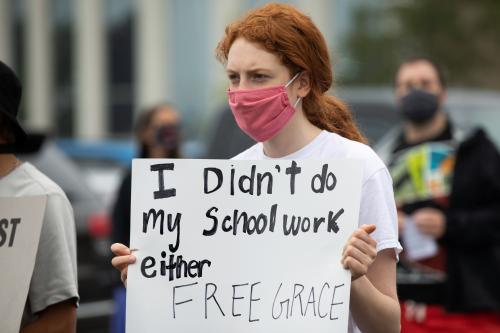The Brown Center Chalkboard recently published an important article on a little-appreciated crisis in our public schools: The chronic teacher absenteeism that costs public schools billions of dollars and millions of hours of effective teaching and lost learning each year. The article reported that, on average, 29% of teachers in the 2015-16 school year were considered chronically absent, and it recommended the consideration of teacher-absence measures in school accountability systems.
Education policies like accountability measures on absence are necessary organizational governance mechanisms that, when implemented effectively, can enable the attainment of important goals. Policies are intended to define what is allowable, ensure coherence, and avoid contradictions about employee behavior and decision-making. Yet by themselves, policies are often not enough to influence behavior or create real change.
What if the problem is not that current teacher-absence policies are weak or unclear, but that school district culture does not sufficiently reinforce the goals the policies are intended to support? Focusing on revising policy, while overlooking the culture in which policy is implemented, risks missing the real problem.
Edgar Schein, a leading scholar and author of the book, “Organizational Culture and Leadership,” describes culture as:
“A pattern of basic assumptions – invented, discovered, or developed by a given group as it learns to cope with problems … that has worked well enough to be considered valid and, therefore, to be taught to new members as the correct way to perceive, think, and feel in relation to those problems.”
I’ve distilled his definition into one of my own: Organizational culture is the collective behaviors, habits, and mindsets of individuals and teams in an organization. In other words, culture is “the way things work around here.”
My experience working with school districts over more than 10 years informs my study of organizational culture. My advisory practice with education leaders, focusing on problems from teacher absenteeism to teacher turnover and more, has often found the roots of such problems in a district’s culture. The good news is that, even as culture can be the culprit that chews up initiatives and undermines results, it can also be the hero. It can become the reason that teachers stay in their schools, become more deeply engaged, and are encouraged to become better at helping kids learn. But this happens only if leaders deliberately make it so.
According to research conducted by Levine and Lezotte, studies of effective schools consistently acknowledge an ethos that is purposeful and conducive to learning. When teachers are chronically absent, school leaders should examine whether it is a sign of disengagement in their work. While chronic illness may be a reason for chronic absenteeism, it’s certainly not the only reason.
Teaching is a challenging job, offset by high purpose and meaning. Still, a 2015 Gallup report found that just 30% of teachers are “engaged in their work,” with the term “engaged” defined as “involved with, enthusiastic about and committed to their work.” Collectively, “not engaged” and “actively disengaged” teachers represent the majority of K-12 teachers. Teachers who are not engaged, or are actively disengaged, will miss an estimated 2.3 million more workdays than teachers who are engaged.
Teaching is a high-stress job, which likely contributes to disengagement. According to a 2013 Gallup-Healthways Well-Being Index, 46% of teachers report high daily stress. And nearly two-thirds of teachers and school staff find their work always or often stressful, a 2017 Education Quality of Life survey showed.
There are many causes of stress in the school workplace, some of them inherent to the job. But others can be found in cultures defined by distrust and fear, pressure to meet unattainable performance goals, inadequate opportunities to learn and grow, the absence of teamwork and mutual support, and feelings that employees’ opinions don’t count. These culture-driven stressors can promote burn out and disengagement. Such experiences can cause teachers to choose to take more days off than a policy might otherwise permit.
Enthusiastic and committed teachers aren’t likely to be chronically absent for non-health reasons. So, leaders who work to eliminate the underlying sources of stress and disengagement among teachers can do more to ensure the adherence to absence policies already in place.
Public education has historically relied on rigid policies to influence behavior and decision-making. Unwanted behaviors, such as chronic absenteeism and disparities in school discipline, are more likely to prompt a call for policy revisions than changes to “the way things get done around here.” This is not uncommon as many leaders, no matter their industry, find human issues too challenging and time consuming to address. This overreliance on policy, however, comes with its own set of limitations and costs.
Policies are limited in their influence on behavior and decision-making. They are written at a point in time. It is hard to fathom devising enough of the right policies to cover every behavior and decision-making possibility. Further, overlooking culture can create opportunities for adverse, unintended outcomes.
In 2009, a cheating scandal rocked Atlanta Public Schools (APS). News reports described a “pattern” of intimidation, fear, threats, retaliation, and pressure, as well as a conspiracy of silence that would come to be identified as underlying reasons for employees’ actions in the largest cheating scandal in the U.S. An investigation by The Atlanta Journal-Constitution showed the district failed to look into many allegations of test cheating despite “statistically improbable increases” on the state’s tests in a year’s time at a dozen schools. In a 2012 report, state investigators cited widespread cheating violations and organized systemic misconduct in APS to boost test scores.
In 2017, Washington, D.C., Public Schools (DCPS) was found to have fraudulently graduated hundreds of students with the assistance of policy violations in attendance, grading, credit recovery, and graduation. As with APS, teachers and administrators felt pressured into passing students to meet performance goals or risk retaliation and job loss.
These two examples may represent what some think of as extremes or exceptions to the rule. Except some 196 school districts across the U.S. during this same time period were found to have suspicious test scores, according to reporting by The Atlanta Journal-Constitution. And around the same time as the DCPS graduation scandal, public schools in neighboring Prince George’s County were reported to have engaged in a graduation scandal of its own.
An organization’s culture, one of the most important things that any leader can attend to, is rooted in the human issues of individuals’ and teams’ behavior, habits, and mindsets. It can be deliberately leveraged to great effect to guide behavior and decision-making to align with policies. As Dwight D. Eisenhower once said, “Leadership is the art of getting someone else to do something you want done because he wants to do it.” Establishing a healthy organizational culture is how leaders get things done.
The process of shifting culture from dysfunctional to functional begins with leaders taking the initiative for what is often viewed as a heavy lift. Most leaders understand that they need employees working at their best together if they are to succeed, but lack a strategy for how to make “the way things work around here” a hero instead of a culprit. To help leaders assume this responsibility with confidence, here are some first steps that can help guide leaders and teams along a journey to establish the culture they want.
First, shared behaviors reflecting core values become “rules of the road” or guardrails that keep employees from going off road. All the conversations throughout the culture-shaping journey create alignment between purpose and strategies and policy, and between employees across the organization. Alignment creates momentum that leaders can use to ensure that everyone is moving in the same direction toward the same goals.
Next, this newly defined culture is integrated across key organizational systems, such as hiring and onboarding, recognition, performance, and communications. A key differentiator between saying culture is important and it being important is the familiar truism: What gets measured is what’s important.
Finally, keep in mind that culture evolves in response to how employees respond to problems, even more mundane ones. Before leaders reach for a policy solution, they might think carefully about the role that culture might be playing to encourage or condone unwanted behaviors and decision-making. They might ask: Is our culture helping or hurting us?
In our discussions of policy solutions, let’s not overlook the role of culture in ensuring successful implementation. The good news is that there is no policy required for leaders to establish the workplace culture that could help their teams and organizations thrive.





Commentary
Focusing on organizational culture—not just policies—can reduce teacher absenteeism
April 30, 2020